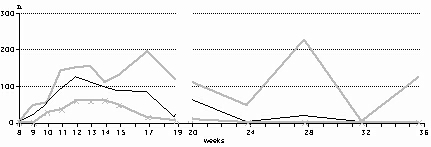An involuntary spasm of the diaphragm causing sudden inhalation accompanied by closure of the glottis (and thus the trachea or windpipe). Fetuses can start to demonstrate this movement pattern at 9-11 weeks of gestation (see figure below). The actual causes of hiccupping in the fetus are unknown.

With a first age of appearance of 9-11 weeks of gestation, in the fetus they are abrupt displacements of the diaphragm, chest and abdomen. Single events last about 1 second, but more frequently occur at intervals 2-3 seconds for periods of up to 20 minutes. They have a high rate of occurrence, the value for 11-17 weeks being about 100 per hour. Like startles they may shift the fetus from the lying surface. The black line stands for the median and the gray lines for the interquartile range. Figure adapted from de Vries, J.I.P., Visser, G.H.A., & Prechtl, H.F.R. (1985). The emergence of fatal behaviour. II. Quantitative aspects. Early Human Development, 15, 333-34 8 for 8 to 19 weeks, and from Roodenburg, P.J., Wladimiroff, J.W., van Es, A., & Prechtl, H.F.R. (1991). Classification and quantitative aspects of fatal movement during the second half of pregnancy. Early Human Development, 25, 19-35 for 20 to 36 weeks.
See Fetal breathing movements, General movements, Glottal, Startles, Stretches
